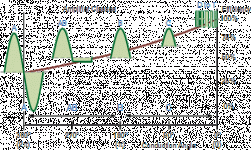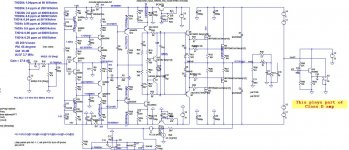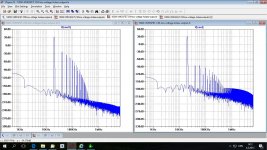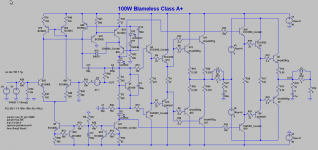How to design 200W Class A power amp with very high efficiency, that was my interest last few months. Some kind of combination of Class A and Class D or T, but what is simple way to do that.
There are different ways to do that, I don’t have all information what’s going on in commercial audio, but I haven’t seen the way I will present here. Normal Class A amp has very low efficiency of around 30%, but with this approach presented here it could be much better with similar sound benefits.
The power amp I will use is modified 100W CFA and 200/400W Class D amp. This CFA is quite similar to my Class AB amp but the output MOSFETS are biased to Class A and power supply is only +-6V with middle point not connected to the ground but to the Class D amp output. Both amps should have the same gain.
I ordered two Class D amps in kit from China and now waiting to arrive, and then I will check if this concept is viable. Simulation shows very good results regarding both, distortion and efficiency.
The Class A amp needs two separate power supply one high voltage for the input blocks and one low voltage for the output transistors.
Attached the schematic as simulated, FFT plot of the Class A amp and to compare with some distorted FFT of simulated Class D amp and the SRPP plot of the output low voltage power MOSFETs. It’s quite easy to find a Class D amp with similar or lower distortion than the one I used in simulation(not real, I used ideal voltage source with distorted input).
Damir
There are different ways to do that, I don’t have all information what’s going on in commercial audio, but I haven’t seen the way I will present here. Normal Class A amp has very low efficiency of around 30%, but with this approach presented here it could be much better with similar sound benefits.
The power amp I will use is modified 100W CFA and 200/400W Class D amp. This CFA is quite similar to my Class AB amp but the output MOSFETS are biased to Class A and power supply is only +-6V with middle point not connected to the ground but to the Class D amp output. Both amps should have the same gain.
I ordered two Class D amps in kit from China and now waiting to arrive, and then I will check if this concept is viable. Simulation shows very good results regarding both, distortion and efficiency.
The Class A amp needs two separate power supply one high voltage for the input blocks and one low voltage for the output transistors.
Attached the schematic as simulated, FFT plot of the Class A amp and to compare with some distorted FFT of simulated Class D amp and the SRPP plot of the output low voltage power MOSFETs. It’s quite easy to find a Class D amp with similar or lower distortion than the one I used in simulation(not real, I used ideal voltage source with distorted input).
Damir
Attachments
Dear Damir,
nice idea - for example see "Devialet Expert Pro" Analog-Digital-Hybrid and similar. I have had the chance to listen to such an (expensive) amplifier.
Unfortunately it may not be as easy as your simulation example. Have you thought about e.g. class D phase shift at higher frequencies?
BR, Toni
nice idea - for example see "Devialet Expert Pro" Analog-Digital-Hybrid and similar. I have had the chance to listen to such an (expensive) amplifier.
Unfortunately it may not be as easy as your simulation example. Have you thought about e.g. class D phase shift at higher frequencies?
BR, Toni
Dear Damir,
nice idea - for example see "Devialet Expert Pro" Analog-Digital-Hybrid and similar. I have had the chance to listen to such an (expensive) amplifier.
Unfortunately it may not be as easy as your simulation example. Have you thought about e.g. class D phase shift at higher frequencies?
BR, Toni
Dear Toni,
I don't know enough about Class D amps, just in what I read about it, no practical experience, but that is way I am going to test it in real life.
I've heard about Devialet, not much how thy did it, and there no to much information just commercial bla bla, and I think thy exaggerate power wise.
How did you like the sound?
BR Damir
...my interest last few months. Some kind of combination of Class A and Class D or T, but what is simple way to do that...
Hi Damir
Harry Dymond, who wrote the nice two pole compensation paper, told me he planned a conference paper on Class D + Linear.
You could check for that, maybe PM him?
Best wishes
David
Hi Damir
Harry Dymond, who wrote the nice two pole compensation paper, told me he planned a conference paper on Class D + Linear.
You could check for that, maybe PM him?
Best wishes
David
Hi David,
What is Harry Dymond alias?
Thanks, Damir
Neutral like a blameless as expected....Devialet...
How did you like the sound?
...
BR, Toni
The sound of Devialet leaves me completely uninterested in the music it plays.
My guess is the class D rf pollution over weighs any sonic benefits of the class A. But then, that is my principal grumble against class D in general. In the case of Devialet this is further exacerbated by the switched mode ps... Still, a lovely solution for the iPhone generation 🙂
My guess is the class D rf pollution over weighs any sonic benefits of the class A. But then, that is my principal grumble against class D in general. In the case of Devialet this is further exacerbated by the switched mode ps... Still, a lovely solution for the iPhone generation 🙂
simed
I think I have seen similar simulation of Class A + Class B, but I don't remember who presented it.
The sound of Devialet leaves me completely uninterested in the music it plays.
My guess is the class D rf pollution over weighs any sonic benefits of the class A. But then, that is my principal grumble against class D in general. In the case of Devialet this is further exacerbated by the switched mode ps... Still, a lovely solution for the iPhone generation 🙂
I hope that the PSRR of the output transistor pairs will reject most of Class D RF pollution coming via low voltage power supply(as simulation shows).
I intend to use linear power supply for Class A (high and low voltage) and SMTP only for Class D and keep in that way the sound of linear Class A amp.
Class A + C
Look for DOGC-MK3. Runs in class A+C mode.
Author is Dr. Borivoje Jagodic.
Website: http://bas.elitesecurity.org/indexV.html
Look for DOGC-MK3. Runs in class A+C mode.
Author is Dr. Borivoje Jagodic.
Website: http://bas.elitesecurity.org/indexV.html
Look for DOGC-MK3. Runs in class A+C mode.
Author is Dr. Borivoje Jagodic.
Website: :::Borina Amaterska Svastara:::
That is different technology called Current Dumping and Borivoje Jagodic did not invented it, but Peter Walker from Quad.
I am very sorry that Dr. Bora past away, his contribution to audio community was high.
I know all of that.
But I thought you are searching for more efficient class A sound....
What about use current dumping topology and replace class C outputs with class D?
But I thought you are searching for more efficient class A sound....
What about use current dumping topology and replace class C outputs with class D?
I know all of that.
But I thought you are searching for more efficient class A sound....
What about use current dumping topology and replace class C outputs with class D?
That is different path and don't think that Class D will not influence the sound in the way I don't like.
The sound of Devialet leaves me completely uninterested in the music it plays.
My guess is the class D rf pollution over weighs any sonic benefits of the class A. But then, that is my principal grumble against class D in general. In the case of Devialet this is further exacerbated by the switched mode ps... Still, a lovely solution for the iPhone generation 🙂
You haven't seen specs.
You never heard that "beast".
There is no RF pollution on outputs.
There is nothing wrong with switch mode power supplies if done right (e.g. Hypex). I have used a 1200W SMPS in my 4 channel mosfet amplifier with great success.
IMHO: modern high end Class D amplifiers (Hypex; diyaudio member ChocoHolic has developed the "LiteAmp" - a very good IRS2092 based design)
don't need Class A hybrid. They are good enough standalone for audiophile listeners. But would be interesting if one could build it as DIY project
Have fun,
Toni
Last edited:
I did classA+classAB. It has nice sound even not as good as the pure class A.
The benefit is the higher power comparing to the dissipation.
Sajti
The benefit is the higher power comparing to the dissipation.
Sajti
The sound of Devialet leaves me completely uninterested in the music it plays.
My guess is the class D rf pollution over weighs any sonic benefits of the class A. But then, that is my principal grumble against class D in general. In the case of Devialet this is further exacerbated by the switched mode ps... Still, a lovely solution for the iPhone generation 🙂
I totally agree of what was said here.
Not sure why one believes Class A + Class D is a good combo. What is wrong with Class A + Class B combo ? Class A + Class B has been proven to work and perform fantastic. As stated here, the Class D very likely introduces issues that totally spoil any good the Class A provides. Phase issue is just one but noise, poor THD and transient response is another. In my opinion High Power Class D is ok in Servo Subs but that's it. True fidelity will never be achieved with a Class D to the same level a decent Class AB offers.
But again just my 2 cent of opinion.
I totally agree of what was said here.
Not sure why one believes Class A + Class D is a good combo. What is wrong with Class A + Class B combo ? Class A + Class B has been proven to work and perform fantastic. As stated here, the Class D very likely introduces issues that totally spoil any good the Class A provides. Phase issue is just one but noise, poor THD and transient response is another. In my opinion High Power Class D is ok in Servo Subs but that's it. True fidelity will never be achieved with a Class D to the same level a decent Class AB offers.
But again just my 2 cent of opinion.
Then look up Hypex class D amplifiers. Better performance than class AB.
- Home
- Amplifiers
- Solid State
- 200W Class A amp with high efficency





